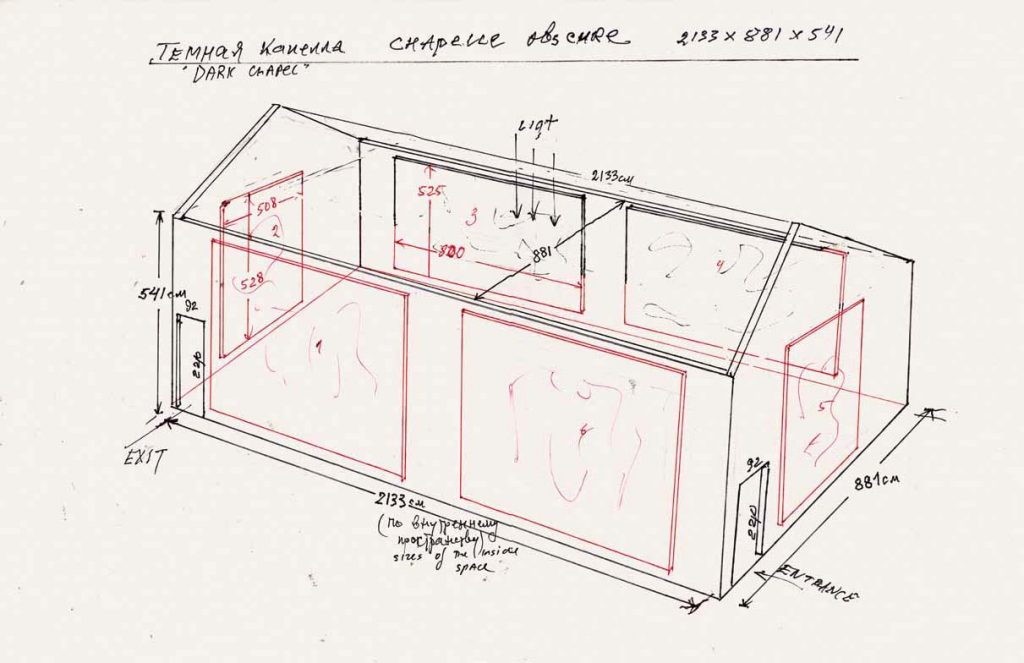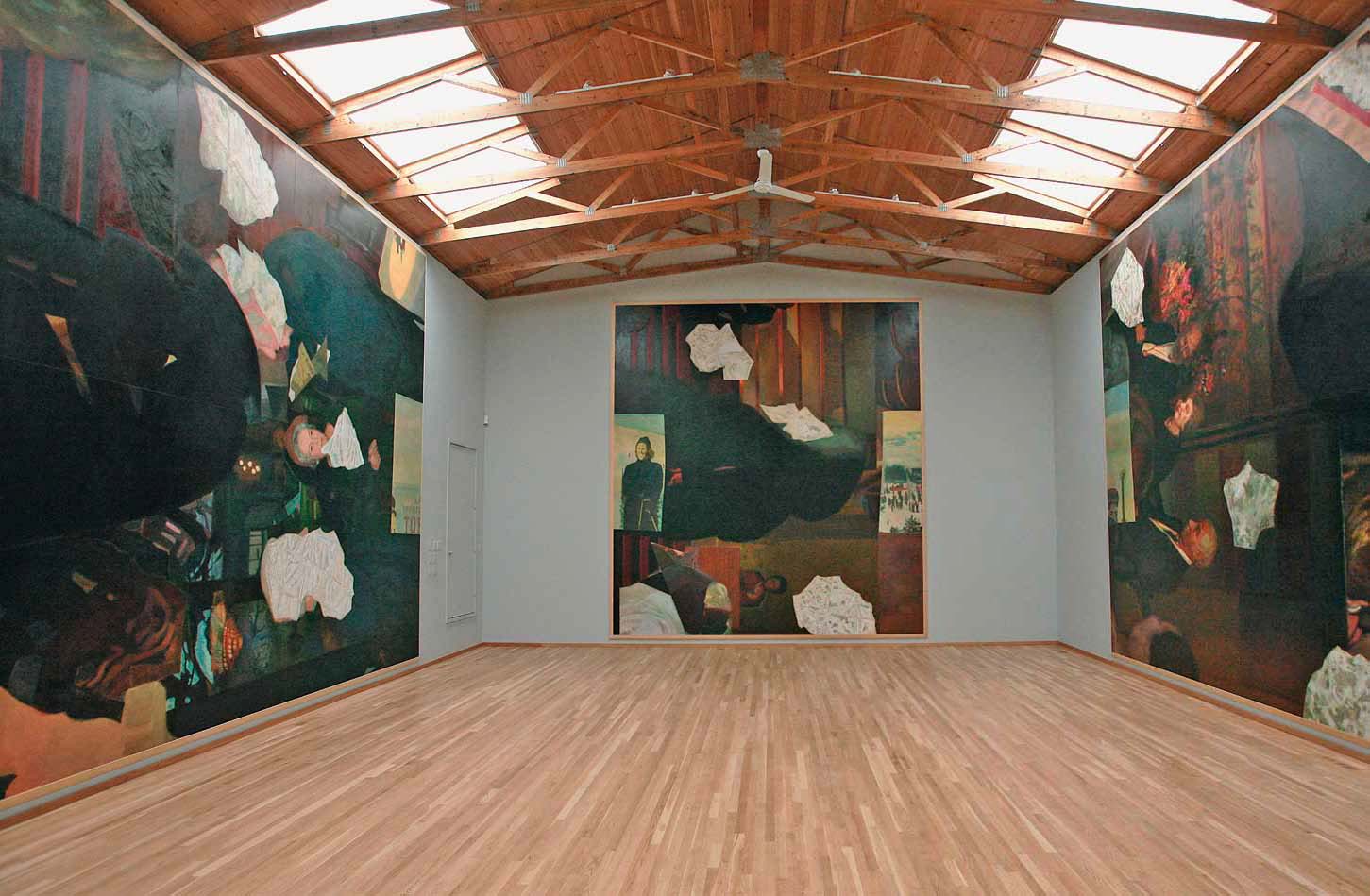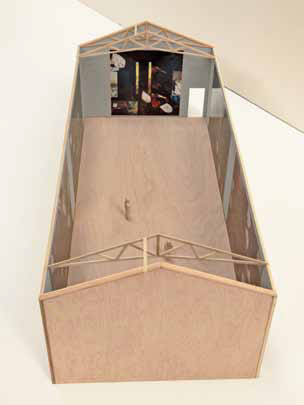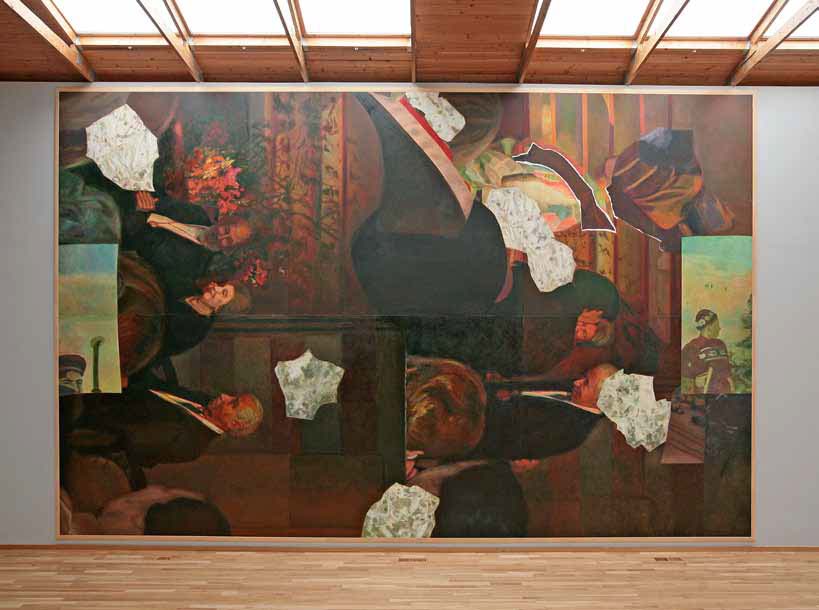The Dark Chapel
with Emilia Kabakov
YEAR: 2014
CATALOGUE NUMBER: 192
PROVENANCE
Collection of Ilya and Emilia Kabakov
NOTES:
Prior to The Dark Chapel a similarly structured building, designed as studio and showroom for the artist’s works, was built on Long Island. In this context Kabakov painted the two large-scale triptychs Three Paintings with a Dark Spot and Three Dark Paintings (both 2010).
See CRI, vol. 3, no. 193, pp. 358–379.
See CRP, vol. 3, nos. 631–633, p. 49; nos. 671–673, p. 103.
EXHIBITIONS
Grand Palais, Paris, France
Ilya et Emilia Kabakov: L’Etrange Cité (Ilya and Emilia Kabakov: The Strange City), Monumenta 2014, organization: Réunion des musées nationaux with support of the Ministry of Culture and Communication, May 10 to June 22, 2014
Power Station of Art, Shanghai, China
伊利亚和艾米莉亚•卡巴科夫:理想之城 / llya and Emilia Kabakov: The Dream City, 上海当代艺术博物馆, August 7 to December 6, 2015
DESCRIPTION
“The Dark Chapel” represents an elongated hall with high walls (5.2 meters), with a conical wooden ceiling and a small entrance door—a space that resembles an old Italian chapel of the times of the Renaissance. Six large paintings hang from floor to ceiling at small intervals along the entire perimeter of the walls. In terms of their coloring and atmosphere, these paintings resemble the dark paintings of the Baroque. (It is from this darkness of the paintings that the chapel gets its name “dark.”) They hang symmetrically one after another: there are two long paintings on each of the two long walls; and two paintings that are more of a square format in the middle of each of the two shorter walls. The upper part of the chapel is lined with windows arranged on the wooden surface.
The six paintings hanging on the walls comprise two “triptychs”: there are two long paintings and one that is smaller in size in each group. Although all six paintings share a similarity in tone and color, each of the groups (each “triptych”) has its own overall concept and plot which is expressed in its name. The first one is called “Three Paintings with a Dark Spot,” and the second is “Three Dark Paintings.” A description of the first “triptych” is below.
“Three Paintings with a Dark Spot”
The three paintings, two large ones and one smaller one, break with modernist tradition and its flat surfaces and light colors, and independent subjects with distinct contours, to move closer to the Baroque tradition of the sixteen and seventeenth centuries, which favored the development of the depth of the painting, its space, and the immersion of each figure in the atmosphere of the scene beyond its frame. The triptych is thus structured as a “tunnel,” using Baroque techniques made famous by Tiepolo’s ceiling paintings. The top and bottom of the painting do not appear in the frame and the whole scene revolves around an axis and vanishes into the depths of the work. In the present instance, the technique is not used on a ceiling fresco, but on paintings hung on a wall, thus creating a strange rotation of the scene toward the background of the painting where the fragments located along the sides seem to be the top and bottom of the painting.
The three paintings are characterized by their size: the two largest measure 5.2 x 8 meters and the smallest 5.2 x 6.8 meters. These sizes were chosen to create a vanishing point for the visitor’s gaze into the depth of the scene. To do so, it is necessary that the visitor not take in the entire painting, as he could if it were exhibited on a white wall, but lose to some extent the edges of the scene when he carefully examines it, which is only possible with a large painting. That said, the size does not guarantee such an effect and many larger works, such as Veronese’s The Wedding Feast at Cana in the Louvre, do not give this impression. In order for this effect to work, another technique from the Baroque period has to be used: chiaroscuro, which consists of working on the volume or atmosphere of the painting whose darkness is penetrated by a sort of particular that gives it an enigmatic “cosmism.” The works of Caravaggio, Pontormo, Bronzino, Rembrandt, and El Greco are good examples of this. The intensity of the scene depicted is such that the viewer does not try to understand what it represents, despite the presence of such an object. An entirely different logic begins to work in such paintings.
All of this should enable the visitor to concentrate on the effect of submersion into the scene without attempting to understand, by tilting his head, who these figures are or what they are doing.
Naturally, the way these paintings are displayed is crucial. Ideally, they should be hung in an empty space, from floor to ceiling and lit from above. No object should be placed in the center of the room at risk of destroying the effect of “submersion in the painting.” Ideally, these works should be exhibited in a separate pavilion and accompanied by music chosen for the occasion. But let’s get back to reality as we are not living in the time of the Medici.
Images
Literature










